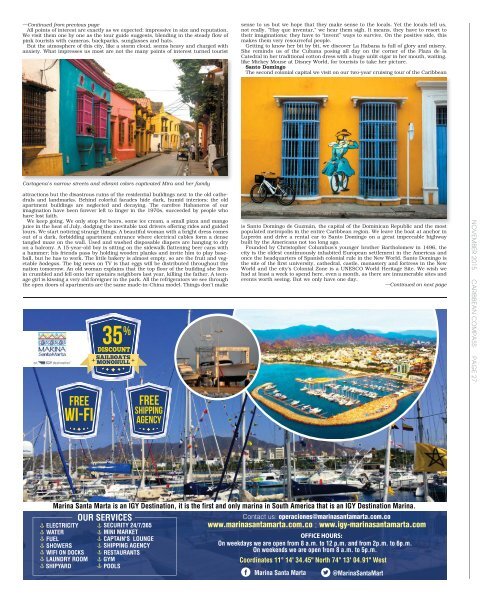Caribbean Compass Yachting Magazine November 2015
Welcome to Caribbean Compass, the most widely-read boating publication in the Caribbean! THE MOST NEWS YOU CAN USE - feature articles on cruising destinations, regattas, environment, events...
Welcome to Caribbean Compass, the most widely-read boating publication in the Caribbean! THE MOST NEWS YOU CAN USE - feature articles on cruising destinations, regattas, environment, events...
Create successful ePaper yourself
Turn your PDF publications into a flip-book with our unique Google optimized e-Paper software.
— Continued from previous page<br />
All points of interest are exactly as we expected: impressive in size and reputation.<br />
We visit them one by one as the tour guide suggests, blending in the steady flow of<br />
pink tourists with cameras, backpacks, sunglasses and hats.<br />
But the atmosphere of this city, like a storm cloud, seems heavy and charged with<br />
anxiety. What impresses us most are not the many points of interest turned tourist<br />
sense to us but we hope that they make sense to the locals. Yet the locals tell us,<br />
not really. “Hay que inventar,” we hear them sigh. It means, they have to resort to<br />
their imaginations; they have to “invent” ways to survive. On the positive side, this<br />
makes them very resourceful people.<br />
Getting to know her bit by bit, we discover La Habana is full of glory and misery.<br />
She reminds us of the Cubana posing all day on the corner of the Plaza de la<br />
Catedral in her traditional cotton dress with a huge unlit cigar in her mouth, waiting,<br />
like Mickey Mouse at Disney World, for tourists to take her picture.<br />
Santo Domingo<br />
The second colonial capital we visit on our two-year cruising tour of the <strong>Caribbean</strong><br />
Cartagena’s narrow streets and vibrant colors captivated Mira and her family<br />
attractions but the disastrous ruins of the residential buildings next to the old cathedrals<br />
and landmarks. Behind colorful facades hide dark, humid interiors; the old<br />
apartment buildings are neglected and decaying. The carefree Habaneros of our<br />
imagination have been forever left to linger in the 1970s, succeeded by people who<br />
have lost faith.<br />
We keep going. We only stop for beers, some ice cream, a small pizza and mango<br />
juice in the heat of July, dodging the inevitable taxi drivers offering rides and guided<br />
tours. We start noticing strange things. A beautiful woman with a bright dress comes<br />
out of a dark, forbidding apartment entrance where electrical cables form a dense<br />
tangled maze on the wall. Used and washed disposable diapers are hanging to dry<br />
on a balcony. A 15-year-old boy is sitting on the sidewalk flattening beer cans with<br />
a hammer; his friends pass by holding wooden planks and invite him to play baseball,<br />
but he has to work. The little bakery is almost empty, so are the fruit and vegetable<br />
bodegas. The big news on TV is that eggs will be distributed throughout the<br />
nation tomorrow. An old woman explains that the top floor of the building she lives<br />
in crumbled and fell onto her upstairs neighbors last year, killing the father. A teenage<br />
girl is kissing a very old foreigner in the park. All the refrigerators we see through<br />
the open doors of apartments are the same made-in-China model. Things don’t make<br />
is Santo Domingo de Guzmán, the capital of the Dominican i Republic and the most<br />
populated metropolis in the entire <strong>Caribbean</strong> region. We leave the boat at anchor in<br />
Luperón and drive a rental car to Santo Domingo on a great impeccable highway<br />
built by the Americans not too long ago.<br />
Founded by Christopher Columbus’s younger brother Bartholomew in 1496, the<br />
city is the oldest continuously inhabited European settlement in the Americas and<br />
once the headquarters of Spanish colonial rule in the New World. Santo Domingo is<br />
the site of the first university, cathedral, castle, monastery and fortress in the New<br />
World and the city’s Colonial Zone is a UNESCO World Heritage Site. We wish we<br />
had at least a week to spend here, even a month, as there are innumerable sites and<br />
events worth seeing. But we only have one day.<br />
—Continued on next page<br />
NOVEMBER <strong>2015</strong> CARIBBEAN COMPASS PAGE 27


















